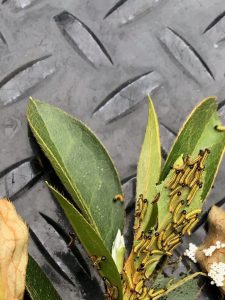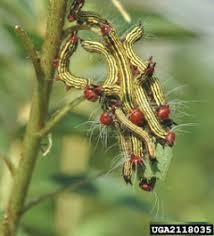Scouting during late spring and summer is a good way to detect pests that feed on foliage, like the azalea caterpillar, or pests residing under the leaf, like aphids and azalea lace bugs.
Recently a landscape professional sent me photos of azalea caterpillars hatching.

Photo by: Jim Houldridge
At this time I am asked about a recommendation for this large caterpillar that is defoliating the leaves of azaleas within a matter of days. This culprit is described as a black and yellow “worm” with a
red head. These caterpillars are noticeable this time of year measuring about 1½ to 2 ½ inches. They have reddish brown legs, head and “neck” area. The body is black with rows of white or pale
yellow stripes.

They feed on the foliage from late summer through early fall. However, there is only one generation a year. The pupae overwinter in the soil. The azalea caterpillar feed together when they are young,
but disperse as they mature.

Photo by: Jim Houldridge
They have been known to defoliate an entire branch or plant during the summer. They can be hand-picked from the plant if only a few are present. If the numbers are larger, Bacillus thuringiensis
should be applied only if the caterpillar is less than ½” in length. Repeated application may be necessary 10 – 14 days later. It is very important that these caterpillars are controlled because azaleas
are not the only host plants. Other hosts include witch-hazel, sumac, apple, crabapple, and red oak. Take some time in the coming days and give your azaleas the attention that they deserve so that
you can enjoy the flowering show next spring.
For more information on selecting and growing azalea, please feel free to contact me at (229) 436-7216 or morganjl@uga.edu.